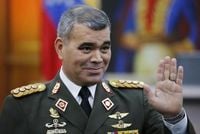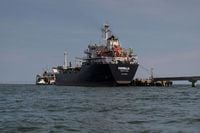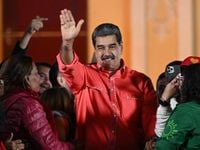In a dramatic escalation of tensions in the southern Caribbean, the United States Navy has deployed a formidable fleet of warships, including three Arleigh Burke-class Aegis guided-missile destroyers, the USS Lake Erie cruiser, and the nuclear-powered submarine USS Newport News, to the waters off Venezuela. The move, initiated on August 26, 2025, is part of a broader crackdown by the Trump administration on South America’s drug cartels, a campaign that has now placed Venezuela—and its embattled president, Nicolás Maduro—squarely in Washington’s crosshairs.
According to multiple sources, including BSS/AFP and The New York Times, the deployment carries not only military might but also diplomatic weight. The destroyers, among them the USS Gravely (DDG-107)—a vessel previously tested in the Red Sea against Iranian-backed Houthi militants—are equipped with Tomahawk cruise missiles capable of striking targets over 1,000 miles away and the advanced Aegis Combat System for missile and drone defense. With these assets, the U.S. has sent a clear message: it will not tolerate what it calls “narco-terrorist” threats in its hemisphere.
The Trump administration’s stance on Venezuela has been uncompromising since 2017, when then-President Trump signed an executive order classifying international drug cartels as foreign terrorist organizations. Chief Pentagon Spokesman Sean Parnell emphasized the rationale behind the latest deployment, telling reporters, “These cartels have engaged in historic violence and terror throughout our Hemisphere—and around the globe—that has destabilized economies and internal security of countries but also flooded the United States with deadly drugs, violent criminals, and vicious gangs.”
This rhetoric comes alongside concrete legal action. In 2020, U.S. authorities indicted President Maduro in absentia on narco-terrorism and cocaine importation conspiracy charges. More recently, the U.S. Department of Justice doubled the bounty for information leading to Maduro’s arrest to a staggering $50 million, branding him “one of the largest narco-traffickers in the world.” The U.S. government has steadfastly refused to recognize the legitimacy of Maduro’s presidency, citing alleged electoral fraud and breaking off formal diplomatic relations in 2019.
Maduro, for his part, has responded with defiance and saber-rattling of his own. On his weekly television program, he declared, “Venezuela is a clean territory, free of drug trafficking... free from coca leaf crops, free! Free from cocaine production.” Echoing this stance, Interior Minister Diosdado Cabello announced the deployment of 15,000 troops to the Colombian border to “bolster security” in Zulia and Tachira states and to combat drug trafficking. “Here, we do fight drug trafficking, here, we do fight drug cartels on all fronts,” Cabello asserted, claiming the seizure of 53 tons of illegal drugs so far this year.
But military posturing has not stopped at the border. Venezuela’s Defense Minister Vladimir Padrino announced the deployment of larger-than-usual naval vessels to a key oil-exporting hub north of Lake Maracaibo and the Gulf of Venezuela. This strategic port is vital for both Chevron Corp.’s shipments to the U.S. and PDVSA’s exports to China. Padrino’s move is seen as a direct counter to the U.S. naval presence, signaling Venezuela’s intent to defend its energy infrastructure amid rising tensions.
Meanwhile, President Maduro has rallied the Venezuelan population to form militias, with government figures boasting of mobilizing 4.5 million militiamen to confront what his regime calls the “Gringo Empire.” Yet, experts like Carolina Jiménez Sandoval, president of the Washington Office on Latin America, remain skeptical of these numbers and the militias’ readiness, describing the move as more “a boisterous way of showing power” than a credible military threat, given Venezuela’s population of just 28 million.
The regional response has been anything but unified. In Trinidad and Tobago, the government issued two conflicting statements within 24 hours: Foreign Affairs Minister Sean Sobers initially declared a non-interventionist stance, downplaying the U.S. naval buildup, only for Prime Minister Kamla Persad-Bissessar to later pledge support for U.S. military action in the Caribbean. She even offered Trinidadian territory for possible use should Guyana request assistance against Venezuela. This abrupt shift, reported by Newsday, has drawn sharp criticism for undermining regional solidarity and bypassing the Caribbean Community (Caricom). Barbados Prime Minister Mia Mottley’s call to preserve the Caribbean as a “zone of peace” stands in stark contrast to TT’s alignment with U.S. interests, raising concerns about the erosion of Caribbean unity and the principles of the Bolivarian Alliance for the Peoples of Our America (ALBA), which champions solidarity and resistance to foreign intervention.
The situation has also exposed rifts within Venezuela’s own opposition. While some leaders, such as Marina Corina Machado, have labeled Maduro as the “head of the Cartel of the Sun,” others, like Henrique Capriles, have urged caution and respect for national sovereignty, warning against any foreign military intervention. Internationally, Mexico’s president has expressed skepticism about U.S. claims linking Maduro to Mexican drug cartels, though other Latin American leaders, such as those in Paraguay, have echoed the U.S. designation of Venezuelan drug organizations as terrorist entities.
Despite the warlike rhetoric and the impressive array of hardware, there is little indication that the United States is preparing for a full-scale ground invasion or regime change in Venezuela. Unlike the “Banana Wars” of the early 20th century, which saw U.S. Marines land in multiple Latin American countries to protect American interests, the current deployment appears designed to project power and disrupt drug trafficking networks rather than topple governments. As The New York Times puts it, “Caracas may need to do nothing, except wait out the U.S. Navy deployment.”
The stakes, however, are undeniably high. Venezuela’s oil infrastructure, a lifeline for both its economy and foreign partners, is now a potential flashpoint. The U.S. has made it clear that it views the Maduro regime as a direct threat to regional security, while Venezuela insists it is the victim of imperial aggression. With 15,000 Venezuelan troops on the Colombian border, 4,500 U.S. service members at sea, and diplomatic relations at their lowest ebb in years, the potential for miscalculation or escalation is ever-present.
As the Caribbean marks another year of independence, the region finds itself at a crossroads—torn between historic commitments to peace and sovereignty, and the hard realities of geopolitics and great power rivalry. Whether this standoff fizzles or flares may depend as much on quiet diplomacy as on the booming guns of modern gunboats.


